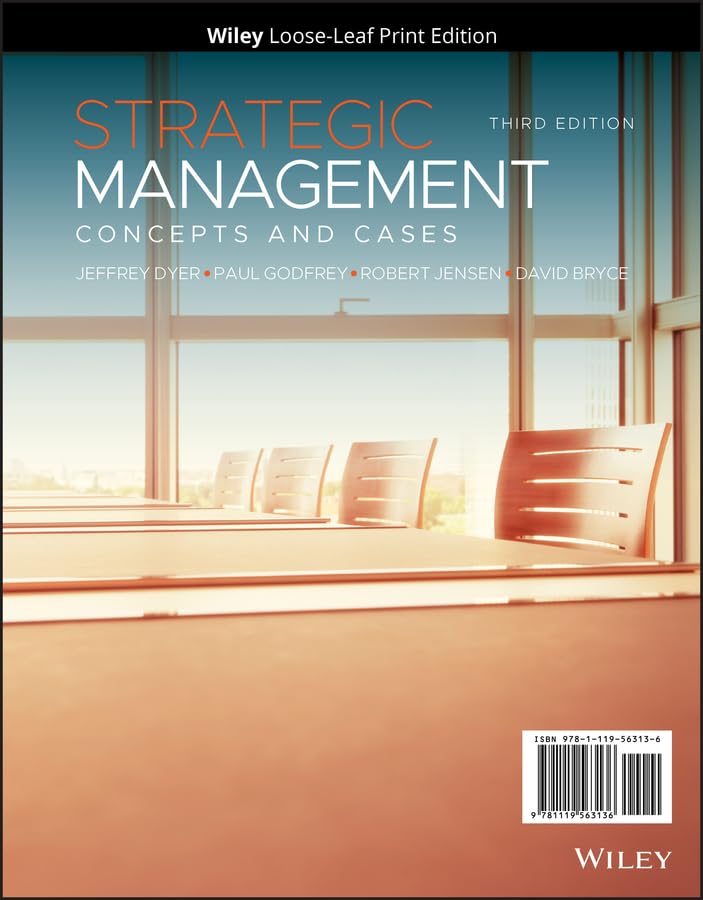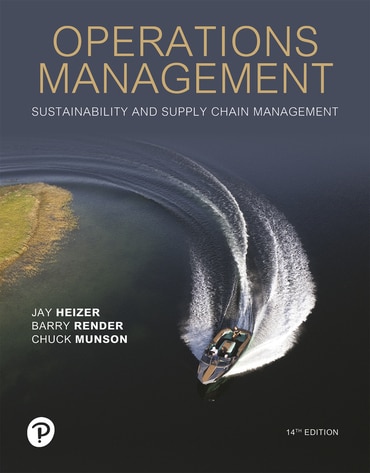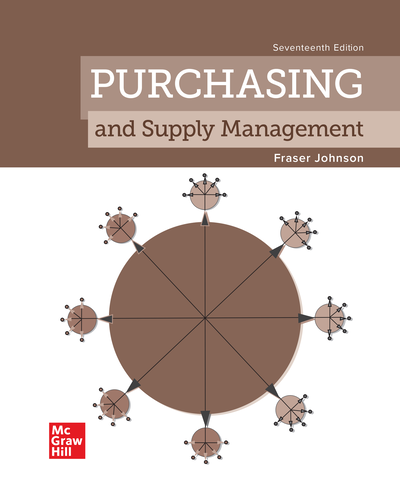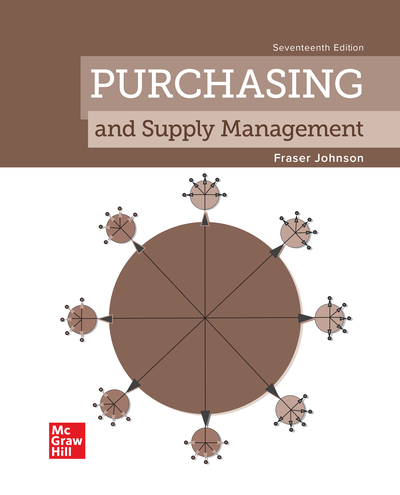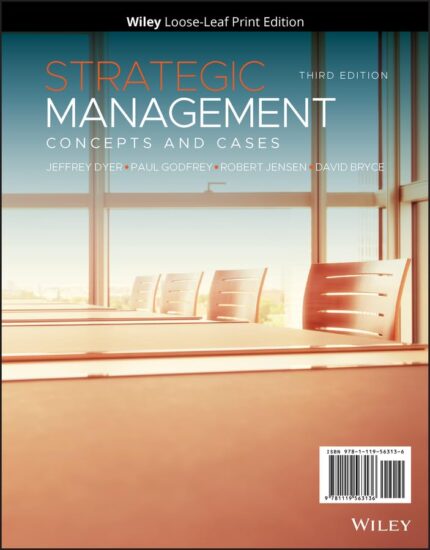Test Bank For Strategic Management: Concepts And Cases, 3rd Edition, Jeffrey H. Dyer, ISBN: 9781119563143
About the Authors vii
Preface ix
Acknowledgments xiii
1 What is Business Strategy? 1
What is Business Strategy? 2
Competitive Advantage 3
The Strategic Management Process 4
What Information and Analysis Guides Strategy Formulation? 7
Mission 8
External Analysis 8
Internal Analysis 9
How are Strategies Formulated? 10
Strategy Vehicles for Achieving Strategic Objectives 10
Strategy Implementation 11
Who is Responsible for Business Strategy? 12
Who Benefits from a Good Business Strategy? 13
Summary 14
Key Terms 14
Review Questions 15
Application Exercises 15
References 15
2 Analysis of the External Environment: Opportunities and Threats 17
Determining the Right Landscape: Defining a Firm’s Industry 19
Five Forces that Shape Average Profitability Within Industries 21
Rivalry: Competition Among Established Companies 21
Buyer Power: Bargaining Power and Price Sensitivity 24
Supplier Bargaining Power 25
Threat of New Entrants 26
Threat of Substitute Products 28
Overall Industry Attractiveness 29
Where Should We Compete? New Thinking About the Five Forces and Industry Attractiveness 30
How the General Environment Shapes Firm and Industry Profitability 31
Complementary Products or Services 33
Technological Change 33
General Economic Conditions 34
Demographic Forces 35
Ecological/Natural Environment 35
Global Forces 36
Political, Legal, and Regulatory Forces 36
Social/Cultural Forces 36
Summary 37
Key Terms 37
Review Questions 37
Application Exercises 38
Strategy Tool 38
References 42
3 Internal Analysis: Strengths, Weaknesses, and Competitive Advantage 44
The Value Chain 46
The Resource-Based View 47
Resources 47
Capabilities 47
Priorities 49
Creating a Sustainable Competitive Advantage: The VRIO Model of Sustainability 49
Value 50
Rarity 50
Inimitability 50
Organized to Exploit 53
Assessing Competitive Advantage with VRIO 53
The Competitive Advantage Pyramid: A Tool for Assessing Competitive Advantage 54
Gathering Data for the Competitive Advantage Pyramid Analysis 55
Using the Competitive Advantage Pyramid 56
Summary 58
Key Terms 58
Review Questions 58
Application Exercises 59
References 59
4 Cost Advantage 61
Economies of Scale and Scope 63
Ability to Spread Fixed Costs of Production 63
Ability to Spread Nonproduction Costs 63
Specialization of Machines and Equipment 64
Specialization of Tasks and People 64
Evaluating Economies of Scale: The Scale Curve 65
Economies of Scope 66
Learning and Experience 67
The Learning Curve 67
The Experience Curve 67
Experience Curves and Market Share 69
How Strategists Use the Scale and Experience Curves to Make Decisions 70
Proprietary Knowledge 72
Lower Input Costs 72
Bargaining Power over Suppliers 72
Cooperation with Suppliers 73
Location Advantages 73
Preferred Access to Inputs 74
Different Business Model or Value Chain 74
Eliminating Steps in the Value Chain 74
Performing Completely New Activities 74
Revisiting Tata 75
Summary 75
Key Terms 76
Review Questions 76
Application Exercises 76
Strategy Tool 76
References 77
5 Differentiation Advantage 79
What is Product Differentiation? 80
Sources of Product Differentiation 81
Different Product/Service Features 81
Quality or Reliability 83
Convenience 83
Brand Image 85
How to Find Sources of Product Differentiation 85
Customer Segmentation 85
Mapping the Consumption Chain 88
Building the Resources and Capabilities to Differentiate 91
New Thinking: Achieving Low Cost and Differentiation 92
Assessing Differentiation Performance 93
Strategy in Your Career: What is Your Unique Value? 94
Summary 94
Key Terms 95
Review Questions 95
Application Exercises 95
Strategy Tool 95
References 96
6 Corporate Strategy 98
Corporate Versus Business Unit Strategy 99
Creating Value Through Diversification 100
Levels of Diversification 100
Value Creation: Exploit and Expand Resources and Capabilities 101
The Eight Ss 102
Destroying Value Through Diversification 106
Methods of Diversification 108
The Acquisition and Integration Process 109
Making the Acquisition 109
Integrating the Target 109
Summary 113
Key Terms 114
Review Questions 114
Application Exercises 114
References 115
7 Vertical Integration and Outsourcing 117
What is Vertical Integration? 118
The Value Chain 119
Forward Integration and Backward Integration 119
Three Key Reasons to Vertically Integrate 120
Capabilities 120
Coordination 121
Control 123
Dangers of Vertical Integration 124
Loss of Flexibility 124
Loss of Focus 125
Advantages of Outsourcing 126
Dangers of Outsourcing 128
Summary 129
Key Terms 129
Review Questions 129
Application Exercises 130
Strategy Tool 130
References 131
8 Strategic Alliances 133
What is a Strategic Alliance? 134
Choosing an Alliance 135
Types of Alliances 137
Nonequity or Contractual Alliance 137
Equity Alliance 138
Joint Venture 138
Vertical and Horizontal Alliances 138
Ways to Create Value in Alliances 140
Combine Unique Resources 140
Pool Similar Resources 141
Create New, Alliance-Specific Resources 142
Lower Transaction Costs 142
The Risks of Alliances 143
Hold-Up 143
Misrepresentation 143
Building Trust to Lower the Risks of Alliances 143
Building an Alliance Management Capability 146
Improves Knowledge Management 146
Increases External Visibility 146
Provides Internal Coordination 147
Facilitates Intervention and Accountability 147
Summary 148
Key Terms 148
Review Questions 148
Application Exercises 149
Strategy Tool 149
References 150
9 International Strategy 152
The Globalization of Business 153
Why Firms Expand Internationally 155
Growth 155
Efficiency 156
Managing Risk 157
Knowledge 157
Responding to Customers or Competitors 158
Where Firms Should Expand 158
Cultural Distance 159
Administrative Distance 160
Geographic Distance 161
Economic Distance 161
How Firms Compete Internationally 162
Multidomestic Strategy—Adapt to Fit the Local Market 163
Global Strategy—Aggregate and Standardize to Gain Economies of Scale 165
Arbitrage Strategy 166
Combining International Strategies 167
How a Firm Gets into a Country: Modes of Entry 168
Exporting 168
Licensing and Franchising 168
Alliances and Joint Ventures 169
Wholly Owned Subsidiaries 170
Choosing a Mode of Entry 171
Summary 171
Key Terms 172
Review Questions 172
Application Exercises 172
Strategy Tool 173
References 174
10 Innovative Strategies That Change the Nature of Competition 177
What is an Innovative Strategy? 178
Incremental Versus Radical Innovation 179
Categories of Innovative Strategies 181
Reconfiguring the Value Chain to Eliminate Activities (Disintermediation) 181
Low-End Disruptive Innovations 182
High-End/Top-Down Disruptive Innovations 184
Reconfiguring the Value Chain to Allow for Mass Customization 185
Blue Ocean Strategy—Creating New Markets by Targeting Nonconsumers 185
Create a Platform to Coordinate and Share Private Assets 186
Free Business/Revenue Models 187
Hypercompetition: The Accelerating Pace of Innovation 189
Innovation and the Product/Business/Industry Life Cycle (S-Curve) 190
Introduction Stage 190
Growth Stage 190
Maturity Stage 191
Decline Stage 191
Summary 192
Key Terms 192
Review Questions 192
Application Exercises 192
References 193
11 Competitive Strategy and Sustainability 194
Understanding the Competitive Landscape 195
Strategic Groups and Mobility Barriers 195
Strategy Canvas 197
Evaluating the Competition 199
What Drives the Competitor? 200
What is the Competitor Doing or Capable of Doing? 200
How Will a Competitor Respond to Specific Moves? 200
Using Game Theory to Evaluate Specific Moves 201
Principles of Competitive Strategy 205
Know Your Strengths and Weaknesses 205
Bring Strength Against Weakness 205
Protect and Neutralize Vulnerabilities 205
Develop Strategies That Cannot Be Easily Copied 206
Competitive Actions for Different Market Environments 206
Competition Under Monopoly 206
Competition Under Oligopoly 207
“Perfect” Competition 208
Dynamic Environments 210
Sustaining Competitive Advantage 210
Summary 212
Key Terms 212
Review Questions 212
Application Exercises 213
Strategy Tool 213
References 213
12 Implementing Strategy 215
Alignment: The 7 S Model 217
Strategy 217
Structure 217
Systems 219
Staffing 219
Skills 219
Style 220
Shared Values 220
Strategic Change 222
The Three Phases of Change 223
The Eight Steps to Successful Change 224
Measurement 227
Line of Sight 227
Summary 230
Key Terms 230
Review Questions 230
Application Exercises 231
References 231
13 Corporate Governance and Ethics 233
The Purposes of the Corporation 234
The Shareholder Primacy Model 235
The Stakeholder Model 236
Governance: Boards and Incentives 238
The Board of Directors 239
Compensation and Incentives 240
Corporate Ethics 241
Corporate Culture and Ethics 243
Creating an Ethical Climate 244
Summary 246
Key Terms 246
Review Questions 246
Application Exercises 247
References 247
14 Strategy and Society 249
Strategy and Social-Value Organizations 250
The Tools of Strategy and the Creation of Social Value 251
External Analysis and the Value Net 251
Internal Analysis: Resources and Capabilities 253
Cost Leadership, Differentiation, and Innovative Strategies 253
Corporate Strategy and Alliances 254
Implementation and Governance 254
Strategy and Social Change 255
Corporate Social Responsibility (CSR) 255
CSR and Firm Performance 256
Social Entrepreneurship 256
Types of Social Entrepreneurship 257
Skills of Social Entrepreneurs 258
Challenges in Social Entrepreneurship 259
Summary 261
Key Terms 261
Review Questions 261
Application Exercises 261
References 262
Glossary 264
Index 269
Case 01 Walmart Stores: Gaining and Sustaining a Competitive Advantage C-1
Case 02 Coca-Cola and Pepsi: The Shifting Landscape of the Carbonated Soft Drink Industry C-12
Case 03A ESPN in 2015: Continued Dominance in Sports Television? C-25
Case 03B ESPN in 2019: A Network in Search of a Solution C-37
Case 04 Southwest Airlines: Flying High with Low Costs C-41
Case 05 Harley-Davidson: Growth Challenges Ahead C-56
Case 06 Ecolab and the Nalco Acquisition: Sustainable Advantage Through Shared Values C-68
Case 07 Nike: Sourcing and Strategy in Athletic Footwear C-78
Case 08 AT&T and Apple: A Strategic Alliance C-87
Case 09 Samsung: Overtaking Philips, Panasonic, and Sony as the Leader in the Consumer Electronics Industry C-100
Case 10 Tesla Motors: Disrupting the Auto Industry? C-114
Case 11 Smartphone Wars in 2013 C-124
Case 12 Lincoln Electric: Aligning for Global Growth C-137
Case 13 ICARUS Revisited: The Rise and Fall of Valeant Pharmaceuticals C-145
Case 14 Safe Water Network: Mastering the Model at Dzemeni C-156
Case 15 Facebook at a Crossroads: Russian Interference in the 2016 Election C-169
Case 16 CVS in 2015: From Neighborhood Pharmacy Provider to Healthcare Company C-182
Case 17 Uber Technologies Inc. C-192
- New Features and Cases in WileyPLUS
Welcome to the latest edition of WileyPLUS! We’ve added some cool updates to make learning about strategies and business even more exciting and useful. Here’s what’s new:
What’s New?
- Fresh New Cases: Every year, we add new stories about different companies to keep things interesting. This edition includes stories about big names like Huawei, Google with Alexa, Vivint Smart Home, ESPN, CVS, and others. We’ve also updated some classic stories to keep them current.
- Updated Chapters: We’ve refreshed the chapters to include the latest information and trends. This way, you get the most up-to-date knowledge.
Features
- Focused Questions: This book helps you answer four important questions about business strategies:
- Where should we compete?
- Why do we win?
- How do we win?
- How will we keep winning in the future?
We’ve also added new ideas about industries, resources, and putting strategies into action.
- Great Cases: The book has a mix of new and classic stories about companies, written by the authors themselves. These include stories about Facebook, Vivint Smart Home, ESPN, CVS Pharmacy, Tesla, and more. Each year, we add new cases to keep things fresh.
- Real-World Examples and Tools: You’ll find stories from real professionals that show how businesses handle different challenges. We also include tools like the Net Promoter Score that real companies use to figure out their strategies.
These updates make WileyPLUS a super useful and current resource to help you learn about business strategies and how they work in the real world.
Related Test Bank
Solution Manual For Strategic Compensation 9th Edition, Joseph J. Martocchio

